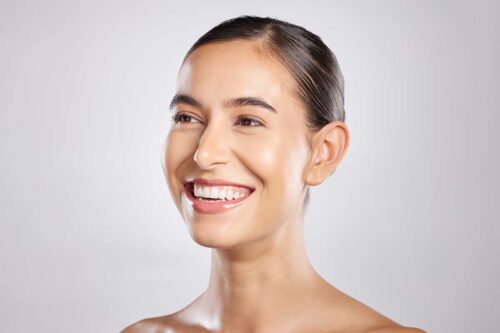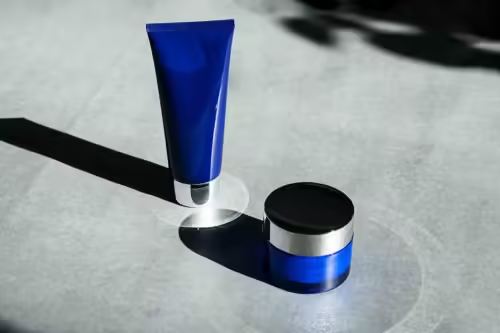Solar keratoses are skin damage caused by long term sun exposure, affecting 40-50% of white Australians. If untreated, they can develop into skin cancer.
Solar keratoses are a form of pre-cancerous sun-damaged skin. They affect approximately half of white Australians over the age of 40.
(Chia 2007)
What are solar keratoses?
Solar keratoses usually appear as flat, pale or pink patches on sun-exposed areas. Most commonly, they occur on the face, ears, temples, nose, back of hands and forearms. Balding men frequently get solar keratoses on the scalp, and women often get them on the chest.
They usually feel rough, with a sandpaper-like consistency and they may be easier to detect by touch than by appearance. Sometimes, solar keratoses become raised with a thick, crusty surface.
Most people with solar keratoses experience no discomfort, but in some cases, they describe mild stinging or a “pins and needles” sensation.
Solar keratoses are a sign of underlying skin damage. They show up as separate spots, but the surrounding may have early subclinical solar keratoses which are not yet visible. If untreated, they are likely to develop into visible solar keratoses.
Solar keratoses and skin cancer
Solar keratoses usually are not a serious health problem. Most remain unchanged without treatment, and many disappear by themselves.
A small proportion (about 5–10%) develops into squamous cell carcinoma within ten years. Squamous cell carcinoma, while usually easily cured, can potentially be serious. It is almost always far more difficult to treat than solar keratoses, so early treatment of solar keratoses is usually recommended.
Treatment
There are several treatments for solar keratoses. They have different side effects, ease of use, success rates and costs. You should discuss the risks and benefits with your doctor and select a treatment or combination of treatments that suits both your condition and your preferences.
Lesion treatment vs. field treatment
Solar keratoses treatment can focus on individual sun spots (lesions), or the entire affected area (field).
- Field treatment — applying a cream to the area — works better and the effects last longer than treating individual sun spots, but it takes longer, often has unpleasant side effects and is more expensive.
- Lesion treatment — where a doctor treats individual solar keratoses by cryotherapy (freezing) or diathermy (burning) — is inexpensive, convenient and quick, but it can cause blisters, skin colour change and, rarely, scars. Some people find it painful.
Your doctor will help you decide on the best treatment for your situation.
Cryotherapy (freezing)
A doctor freezes individual spots using liquid nitrogen. This is an inexpensive one-off treatment and is useful for people with a small number of solar keratoses. It’s not useful for treating subclinical solar keratoses.
This is a popular option for people who want to have treatment on the spot and not worry about applying creams or ointments later.
Cryotherapy tends to cause a burn-like effect in treated areas with redness and blisters which take 2-3 weeks to heal. A small number of people (less than five per cent) develop pigmentation changes (either more or less pigmentation) at treated sites.
Prescription creams and ointments
People with many solar keratoses may get better results from applying a cream to affected areas rather than treating individual spots (field treatment).
This type of treatment can get rid of subclinical (invisible) spots and the recurrence rate is lower than with individual spot treatment.
The field treatment most commonly used in Australia is 5-fluorouracil cream (Efudix), applied to the affected area once or twice daily for up to 4-5 weeks. This treatment causes irritation and redness of the skin during the period of treatment and sun exposure must be avoided during this time. However, of all the treatments, a course of Efudix has been shown to result in the greatest patient satisfaction 12 months later.
An exciting new treatment is a combination cream containing 5-fluorouracil and calcipotriol (a form of vitamin D). This combination works as effectively as 5-fluorouracil by itself with the advantage that most solar keratoses can be effectively treated in only 4 days. A further benefit of this treatment is that skin cancers are less likely to develop in the treated area for three years. This combination is not readily available in most pharmacies and must be prepared by a compounding pharmacy.
Other prescription treatments include imiquimod (Aldara) and diclofenac (Solaraze). These have not been shown to be any more effective than 5-fluorouracil.
Side effects of all the field treatments include redness and sometimes blistering of the skin. These effects usually clear up about two weeks after completing the treatment.
Photodynamic therapy (PDT)
Photodynamic therapy is a combination treatment, where a topical cream is activated by light. It is a useful treatment if there are multiple solar keratoses and a single one-off treatment is preferred rather than repeatedly applying a cream.
Photodynamic therapy involves several steps, performed at the clinic over several hours:
- Preparation of the skin
- Application of aminolevulinic acid cream
- Waiting for the cream to penetrate into the skin
- Activating the cream with light, either red light LED phototherapy or intense pulsed light. Sometimes both lights are used in combination.
Learn more about photodynamic therapy…
Electrocautery (burning)
Like cryotherapy, this treatment is used on individual sun spots. It involves burning the spots and is useful for especially thick and crusty sun spots because it penetrates deeper than cryotherapy.
Diathermy is usually done under local anaesthetic and limited to one or two spots at a time.
It has a higher risk of scarring than other treatments.
Vitamin B3 (nicotinamide) tablets
Vitamin B3 (nicotinamide), taken orally, helps treat solar keratoses. It has been shown to reduce existing solar keratoses by about 30 per cent, so is most useful in combination with other treatments.
In recent research in people at high risk (which would typically include those with many solar keratoses), vitamin B3 prevented many basal and squamous cell carcinomas.
Further research is necessary to determine the effect in people at lower risk and whether vitamin B3 can also prevent melanoma.
The correct dosage of vitamin B3 is nicotinamide 500mg twice daily.
Learn more about vitamin B3 and skin cancer…
Tea tree oil
Recent research has shown that some people have successfully treated solar keratoses with tea tree oil, experiencing fewer side effects than with other treatments. The best results have been achieved specially-formulated products specifically developed for skin treatment. These products are not yet considered a mainstream treatment for solar keratoses.
Salicylic acid
Salicylic acid creams and shampoos can help break down the thick, crusty top layer that often appears on solar keratoses. By itself, salicylic acid is not an effective treatment for solar keratoses, but your doctor may recommend you use it on the affected area prior to using other treatments.
Saliylic ointment preparations include:
- Coco-Scalp ointment, available from pharmacies
- Our own Scaly Skin ointment, prepared by a compounding pharmacist to our specifications. This ointment is available at Spot Check Clinic. It has a higher strength of salicylic acid than Coco-Scalp ointment.
Prevention
Solar keratoses occur mainly in fair skinned people with a history of many sun exposures over a long period. This means that once you have been diagnosed with solar keratoses, you are likely to develop more in future.
You can reduce the number of future solar keratoses by minimising your sun exposure during high risk times. Using SPF 30-50+ broad spectrum sunscreens, as well as protective hats, long sleeves and pants can improve the general condition of your skin as well as reducing the risk of skin cancers.
Also known as
Symptoms and signs
- Rough, dry pink or pale patches, commonly affecting the face, scalp, hands and forearms
- Some solar keratoses have a thick crust on the surface.
Risk factors
- Long term exposure to ultraviolet radiation: usually long periods of time spent in the sun over many years
- Fair skin
- Increasing age
- Smoking
Prognosis / outcome
Progression
Procedures for
solar keratoses
- Cryotherapy (freezing)
- Electrosurgery
- Photodynamic therapy (PDT)
Medications for solar keratoses
- Fluorouracil
- Fluorouracil / calcipotriol cream: “FU/Cal”
- Imiquimod
- Vitamin B3 (nicotinamide) tablets


































